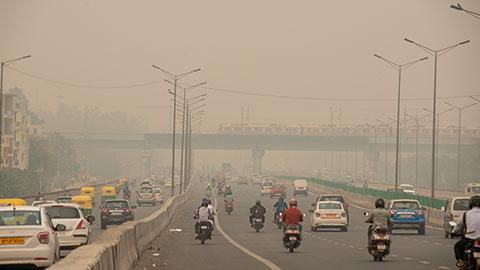More stringent regional and local action required to curb air pollution in Delhi in winter: TERI study

December 9, 2021: With the Capital left gasping for breath yet again, a new study from The Energy and Resources Institute (TERI) presents pathways to reduce PM2.5 concentrations and models different future scenarios. The study titled 'Cost-effectiveness of interventions for control of air pollution in Delhi’ and supported by Bloomberg Philanthropies, released on Thursday, December 9, also assesses the cost effectiveness of multiple interventions and the reductions in PM2.5 concentration it can bring about.
The study makes three future projections – for 2022 in the short term, 2025 in the medium term, and 2030 in the long term for assessment of air quality and cost scenarios for different interventions. In the business as usual scenario, PM2.5 concentrations in winter are expected to fall by 9%, 21%, and 28% in 2022, 2025, and 2030 respectively, when compared to 2019, the base year of the study. Though the PM2.5 concentrations may fall marginally over the years, the levels will continue to remain significantly above the national standards of 60μg per m³, notes the study.
In 2019, the PM2.5 concentrations in Delhi violated the annual average standards by about three times. Transport (23%), industries including power plants (23%), and biomass burning (14%) were the major contributors to prevailing winter time PM2.5 concentrations in Delhi during 2019.
The study calls for more stringent controls to curb emissions in the NCR and the rest of the airshed – a geographical area within which air is confined – if winter season PM2.5 levels are to be brought down considerably. Airshed level controls can reduce winter season PM2.5 concentrations by 35% by the year 2030 when compared to the business as usual scenario.
Dr Vibha Dhawan, Director-General of TERI, says, "Air pollution should be focused as a problem throughout the year not only during the winter season. Stringent actions are needed in the whole airshed to improve air quality in the NCR. Instead of completely banning the essential activities, it is important to switch to the cleaner options."
"Air pollution levels in Delhi are worsened by regional sources which add to the local sources within the city. Airshed-based regional scale air quality controls are required for effective control of air quality in the region," points out Dr Anju Goel, co-project investigator and fellow at TERI.
Priya Shankar, who leads India climate and environment programs at Bloomberg Philanthropies, says, "Given the severity and scale of the air pollution crisis, we need multi-level action and collaboration across government, business, civil society, and citizens. This analysis shows that progress in improving Delhi's air quality is possible with stronger and sustained mitigation efforts."
The study estimates the emission and PM2.5 concentration reduction potentials of different policy interventions across sectors such as transport, biomass and industries. It also assesses the health and economic co-benefits of an airshed approach to address air pollution, and calculates direct and associated benefits like an additional economic benefit of Rs 430 billion ($6.2 billion), if regional PM2.5 control strategies are implemented between 2022-2030.
It is expected that with interventions including electrification of vehicles, implementation of environmental standards of thermal power plants, fleet modernization, shift to public transport etc in the airshed region, annual average standard can be met. However, in order to achieve national ambient air quality standards during winter, additional controls such as curbing ammonia release in farms, enforcement of full ban on refuse burning, converting coal-based power plants to clean energy, most stringent dust suppression control, shift to cleaner technology for brick kilns, use of induction cook-stoves, and stricter control of dust from construction activities, are required.
According to the study, implementation of alternative control strategies across the whole airshed over the business as usual scenario can avoid over 14,000 mortalities in 2022, and 12,000 in 2030 in Delhi NCR. These avoided mortalities can result in economic benefits of around Rs 480-430 billion ($6.9 - $6.2 bn) in the year 2022-2030.
To access the full report Click here
For details, contact:
Gunjan Jain - gunjan.jain@gsccnetwork.org
P Anima – animap@teri.res.in
Sumit Bansal - sumit.bansal@teri.res.in
Shweta Singh - shweta.singh@teri.res.in
